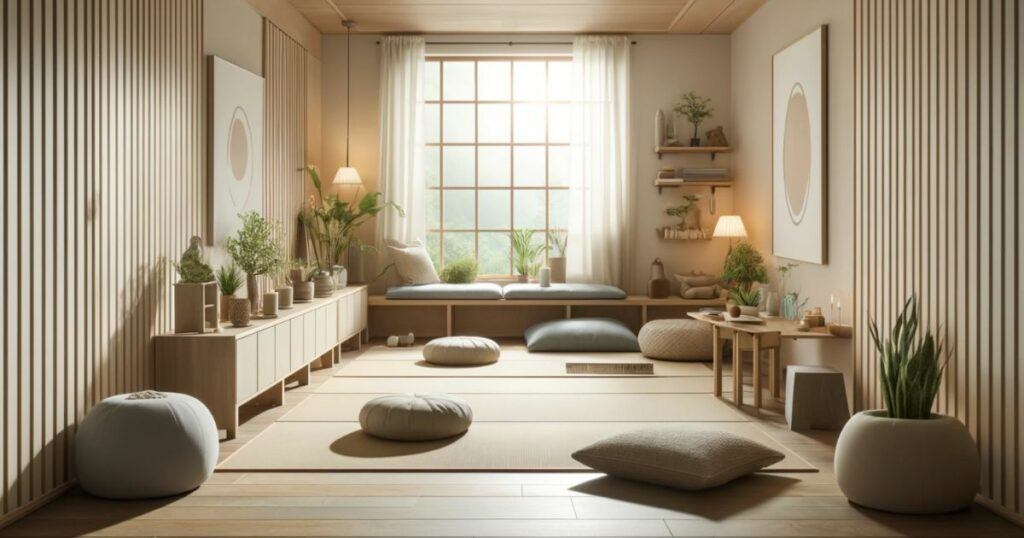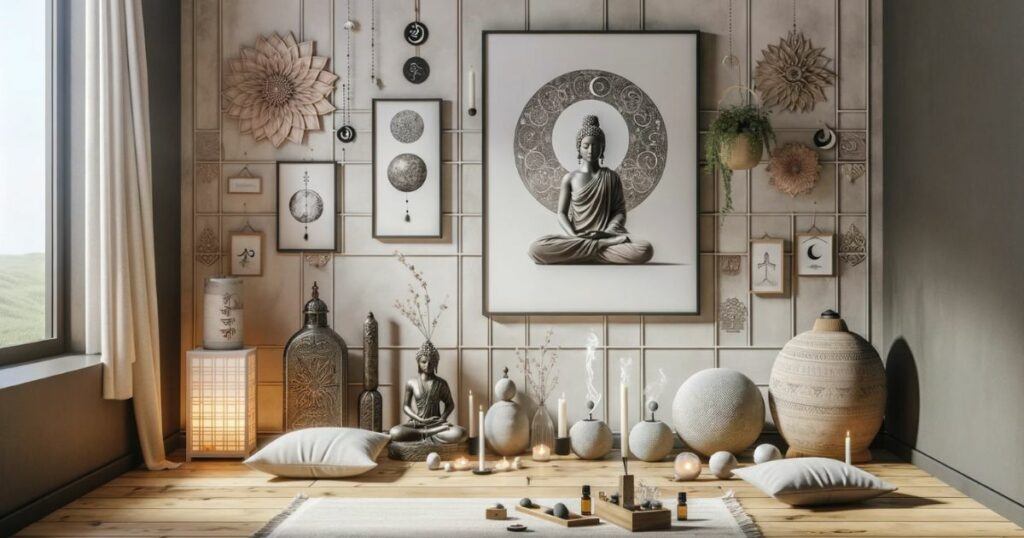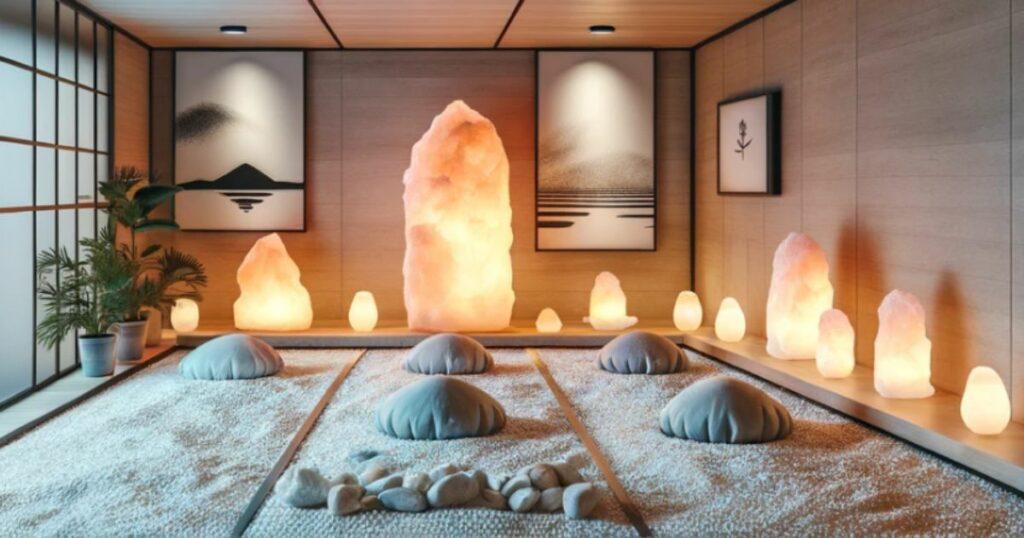
Creating a meditation room in your home can be a game changer for enhancing your practice, providing a quiet space to retreat and find peace. In this post, I’ll share some different meditation room design ideas to help you create a space that supports relaxation and mindfulness. Whether you’re new to meditation or a seasoned practitioner, these tips will help you design a room that supports your journey.
(This post contains affiliate links. If you make a purchase through these links, I may earn a commission at no extra cost to you.)
Understanding the Essentials of a Meditation Room
Why a Dedicated Space Matters
Having a dedicated meditation space offers a number of psychological and emotional benefits. It serves as a physical reminder to practice regularly. It also helps create a sense of sanctuary away from daily stresses. A well-designed meditation room even encourages consistency, making it easier to develop and maintain your meditation habit.
Basic Elements of a Meditation Room
A meditation room should be peaceful and quiet, providing a space free from noise and distractions. Minimalism is ideal; keep the room simple and clutter-free to create a calming environment. Comfort is also important, so include items that encourages relaxation, such as cushions and soft lighting.
Choosing the Right Location
Finding the Perfect Spot
The perfect location for your meditation room is a quiet corner of your home where you can be undisturbed. Do your best to get as much natural light as you can, as sunlight can enhance positive energy. If indoor spaces are limited, maybe you can consider an outdoor spot like a garden or patio for a nature-inspired retreat.
Indoor vs. Outdoor Spaces
Indoor spaces are typically more controlled and comfortable, offering protection from the weather. However, creating an outdoor meditation area can connect you with nature, providing fresh air and natural sounds. Choose the option that best suits you, but at the same time, there’s no reason you can’t do both, if the options are available to you.

Designing for Comfort and Functionality
Seating Options
Comfortable seating is critical for relaxation. Meditation cushions, such as zafus and zabutons, provide excellent support.
- Meditation Cushions: Cushions like zafus and zabutons provide comfortable seating and support.
- Chairs and Benches: Ideal for those who prefer not to sit on the floor.
- Floor Mats and Rugs: Soft, cushioned mats or rugs can make the floor more comfortable.
Check out this article highlighting 18 meditation tools that will help, improve and prolong your practice!
Lighting
Lighting can play a significant role in creating a calming atmosphere as well. Natural light is ideal, so choose a space with windows if possible. For artificial lighting, opt for soft, dimmable lights, candles, or string lights to create a serene ambiance.
- Natural Light: Utilize windows to bring in natural light, which can create a calming atmosphere.
- Artificial Lighting: Soft, dimmable lights are best. Consider using lamps or string lights.
- Candles: Provide a soft, flickering light that can facilitate relaxation.
Temperature Control
Maintaining a comfortable temperature is also important for relaxation. Use fans or heaters as needed, and have blankets available for extra warmth. This ensures you remain comfortable and focused during your meditation sessions.
Aesthetic and Atmosphere
Color
Choose calming colors like blues, greens, and neutrals to create a serene environment. Avoid bright, stimulating colors that can be distracting. The goal is to create a space that feels peaceful and inviting, so soft, inviting colors are recommended.
Textures and Materials
Incorporate soft fabrics for cushions and blankets to add comfort. Natural materials such as wood, bamboo, and stone can bring a touch of nature indoors as well. These elements help create a soothing, harmonious space.
Incorporating Nature
Adding greenery, such as plants and flowers, can enhance the room’s tranquility and improve air quality. Small water features, like fountains, can provide soothing sounds and a calming ambiance. These natural elements can contribute to a peaceful environment.

Personalizing Your Meditation Room
Decorative Elements
Personalize your meditation room with items that inspire you, such as art, quotes, and spiritual symbols. These elements can strengthen your connection to the space and make it uniquely yours. Keep decorations minimal to maintain a clutter-free environment.
- Inspirational Art and Quotes: Hang art that inspires you or place quotes around the room.
- Spiritual Symbols and Statues: Include items that hold personal or spiritual significance.
Creating a Sensory Experience
You can also engage your senses with essential oils, incense, or candles to create a soothing aroma. Incorporate sounds like bells, chimes, or soft music to add to the sensory experience. These elements can deepen your meditation practice and promote relaxation.
- Essential Oils and Diffusers: Use lavender, eucalyptus, or other calming scents.
- Incense and Candles: These can add a soothing aroma to your space.
- Sound: Incorporate bells, chimes, singing bowls or soft music to enhance the sensory experience.
Advanced Design Ideas
Themed Meditation Rooms
Ever consider creating a themed meditation room, such as a Zen garden style with sand and stones, or a Himalayan salt room with salt lamps and bricks? You can also combine yoga and meditation in a single space for a versatile practice area. These themes can add a unique touch to your meditation room.

- Zen Garden Style: Incorporate sand, stones, and minimalist elements.
- Himalayan Salt Room: Use salt lamps and salt bricks for a unique ambiance.
- Yoga and Meditation Combo Room: Create a space that accommodates both practices.
Technology Integration
You can integrate technology with sound systems for playing guided meditations or calming music. Smart lighting solutions can also enhance the room’s ambiance, allowing you to adjust the lighting with ease. Technology can complement your meditation practice without being intrusive.
Accessibility
Design your meditation room to be accessible for different mobility needs. Ensure the space is easy to navigate and use, with features like wide doorways and accessible seating. This makes the room welcoming and inclusive for all practitioners.
————————————————————————————————————————
Creating from your own meditation room design ideas can be transformative, offering a serene retreat to enhance your mindfulness practice. Explore advanced design ideas, such as themed meditation rooms and technology integration, to personalize your space. Please share your thoughts, ideas, or questions in the comments below. How have you designed your meditation room, or what challenges are you facing in creating one? Let’s inspire and support each other in building peaceful sanctuaries at home.
FAQ
Creating a meditation room can spark many questions. Here are answers to some common questions to help you get started on your meditation room design ideas.
How to design a meditation room?
Designing a meditation room involves creating a space that is quiet, comfortable, and free from distractions. Start by choosing a location with natural light and minimal noise. Keep the décor simple with calming colors, and add comfortable seating like meditation cushions or a bench.
What color should a meditation room be?
The color of your meditation room can significantly impact its feel and impact. Calming colors like blues, greens, and neutrals are ideal for creating a peaceful environment. Avoid bright, stimulating colors that can be distracting during meditation.
How to set up a zen room?
To set up a zen room, focus on simplicity and natural elements. Use minimal décor by incorporating natural materials like wood, stone and water. Add plants for a touch of greenery and include a water feature to top off the calming atmosphere.
How do you create ambiance for meditation?
Creating ambiance for meditation involves engaging all your senses. Use soft lighting, such as candles or dimmable lights, to create a calming glow. Add soothing scents with essential oils or incense and incorporate gentle sounds like chimes, bells, or soft music to enhance the meditative atmosphere. And soft cushions will invite relaxation.
Which direction should a meditation room face?
The direction your meditation room “faces” can definitely have an effect on its energy. Ideally, a meditation room should face east or north, which are considered auspicious directions in many traditions. East-facing rooms capture the morning light, while north-facing rooms offer consistent, cool light throughout the day.
In the End,
Designing a meditation room is a personal and rewarding process. By considering the essentials, choosing the right location, and personalizing your space, you can create a space that helps build your meditation practice. Remember, the goal is to create a space where you feel comfortable, relaxed, and inspired to meditate regularly.
Have you designed your own meditation room? Share your experiences and tips in the comments below!





